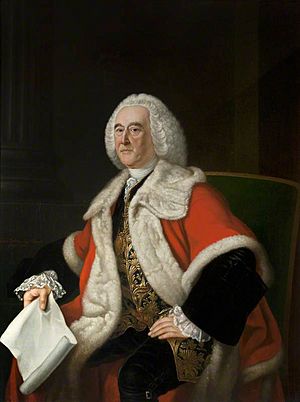George Drummond (politician) facts for kids
George Drummond (1688 – 1766) was an important Scottish politician and accountant. He served as the Lord Provost of Edinburgh many times between 1725 and 1764. This role is like being the mayor of a big city. Drummond helped shape Edinburgh into the city we know today.
Contents
Early Life and Career
George Drummond was born in 1688 at Newton Castle in Blairgowrie, Perthshire. He was related to an earlier George Drummond who was also a Provost of Edinburgh. Young George went to the High School in Edinburgh.
He started his career as an accountant. At just 18 years old, he worked on the financial details of the 1707 Act of Union. This was a major event that joined Scotland and England. By age 20, he became the Accountant General for the Board of Customs. He was later promoted to Commissioner in 1717.
Facing Challenges in Edinburgh
In the 1720s, there were some big changes happening in Scotland. The English government wanted to change how taxes were collected. This caused some unrest. For example, in 1725, people protested against a new tax called the malt tax. This tax was on malt, which is used to make beer.
Drummond was a strong supporter of the British government. He was against the Jacobites. The Jacobites were people who wanted the old royal family back on the throne. Drummond even fought against them in the Battle of Sheriffmuir in 1715. Later, in 1745, he helped organize volunteers to defend Edinburgh. This was when a Jacobite army, led by Charles Edward Stuart, tried to take the city.
Improving Edinburgh
George Drummond joined the Edinburgh Town Council in 1716. He worked hard to make Edinburgh a better place.
Building New Hospitals and Institutions
He helped raise money to build the Royal Infirmary. This was a hospital designed by William Adam in 1738. It quickly became a very famous teaching hospital. In 1760, he also helped start the Royal Exchange. This building later became the Edinburgh City Chambers, which is where the city council meets.
Drummond was also a big supporter of the University of Edinburgh. He encouraged the university to grow. He even helped create five new teaching positions for doctors there.
Creating the New Town
Drummond is most famous for his big idea to build Edinburgh's 'New Town'. The old part of Edinburgh, known as the Old Town, was very crowded and not very healthy. Drummond wanted to create a new, modern part of the city.
In 1766, he convinced the Town Council to support his grand plan. They held a competition to design the new area. A young architect named James Craig, who was only 21, won the competition.
Drummond also started the long process of draining the Nor' Loch in 1759. This was a dirty, unhealthy loch (lake) that separated the Old Town from where the New Town would be. He also saw the need for the North Bridge. This bridge would connect the Old Town to the New Town. He laid the first stone for the North Bridge in 1763.
Later Life and Legacy
George Drummond was also a Freemason. He joined a Masonic lodge in 1721. He even served as the Grand Master Mason of the Grand Lodge of Scotland from 1752 to 1753. In this role, he helped lay the foundation stone for the new Royal Exchange building.
Drummond's own house was located north of the city. After he died, this area was redeveloped. Today, a street called Drummond Place is named in his honor. It is located where his country house once stood. Another street, Drummond Street, is also named after him.
George Drummond passed away in Edinburgh on December 4, 1766. He is buried in the Canongate Churchyard, which is the burial ground of the Canongate Kirk. His vision and hard work helped transform Edinburgh into a modern city.
Images for kids



